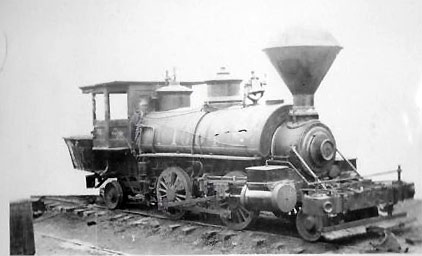|
|
A Turntable and Its Turn-back Trains
- an esoteric railroad tale of Turn of the 20th Century Palo Alto |
|||
|
||||
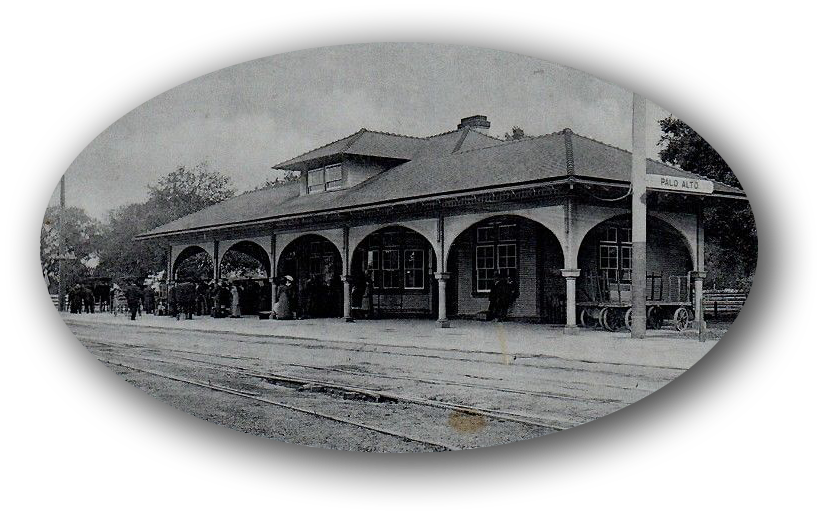 Palo Alto's original depot in the early 20th Century - from an old postcard |
||||
| In the 1880's and 1890's, Southern Pacific operated what generically is called "turn-back" passenger trains on the Peninsula between San Francisco and Menlo Park. As the term makes evident, after leaving 3rd & Townsend depot these trains and crews only ran as far as Menlo Park, where they reversed direction and took on a new schedule back to San Francisco. The rise of Menlo Park as San Francisco's most distant suburb - and a wealthy one at that -, along with the opening of Stanford University in next door in Palo Alto had precipitated the need for more frequent service, which otherwise was not necessary all the way down to "Cowtown", San Jose. In 1891, three out of ten weekday passenger trains on the Peninsula in each direction ran San Francisco to Menlo, while only one terminated / originated in San Jose. (see timetable below left). At the time, Menlo's facilities were minimal, consisting of a pretty little "Victorian" depot (still extant), a water plug and a single track main line with a side track where engines ran around their trains. Although the author has encountered no supporting empirical evidence, it is quite possible that tank engines covered the service - possibly including one or two of the 2-6-2T commuter engines normally purposed to the East Bay - given that there were no turning facilities between Baden and San Jose. (see tank engines of the 'turn-back era' below) Leland Stanford founded Menlo's antithesis, Palo Alto, to serve the various residential and business needs of his university's student body. He intended Palo Alto to be a "dry" town to keep students pointed towards the straight and narrow. To this end, he bought up every parcel of land that he could and inserted CC&R's into the deeds forbidding liquor sales before divesting himself of it. My grandfather did not sell out. (The CC&R's finally failed a court test in the 1950's). Stanford's teetotaling initially put a significant damper on the town's development, because students desiring to whet their whistles had no choice but to cross San Francisquito Creek to avail themselves of Menlo Park's enticing contingent of saloons. Menlo's more sober merchants benefitted from their proximity, while Palo Alto's businessmen came out on the short end. |
||||
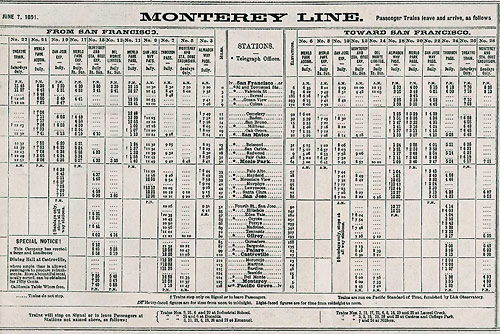
Before & after: |
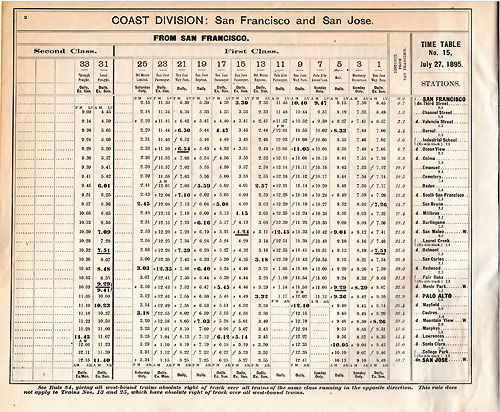 |
|||
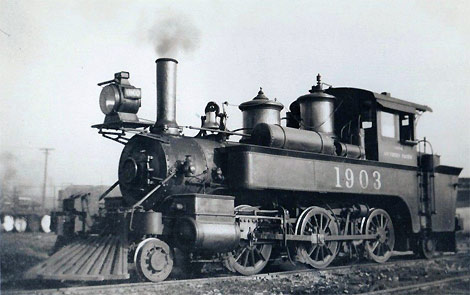 |
Even though the paucity of sprits dampened Palo Alto's growth, by the early 1890's, the town's population had expanding sufficiently enough to prompt SP to extend its turn-back trains the extra mile to Stanford's town. Palo Alto's railroad infrastructure then consisted of a depot, freight house, a single track main with a side track, a couple of warehouses and a spur that led into the Stanford University grounds, but no watering facilities. In late January 1893, the San Francisco Chronicle reported that SP was well on its way towards moving the turn-back operation to Palo Alto. After securing sufficient land for a small yard, the company constructed a new turntable and installed a switch connecting it to the main track. The new lengthened service was promised for "the near future". The turntable, a fifty foot wooden "gallows" affair would allow the employment of conventional tender-equipped locomotives, alleviating the need for scarce tank engines. It had secured the neccesary land, SP elected to install a 50 foot wooden turntable in Palo Alto to allow the use of conventional tender-equipped locomotives in the lengthened schedules. Once the new service began, eastbound trains probably arrived via the Palo Alto siding, where their engines were cut off, sent for a spin on the turntable, run up to Menlo for a drink, since the new terminal lacked a water tank. Whether or not the entire crew rode along to avail themselves of Menlo's saloons is open to conjecture. After completing the "work" at Menlo, the crew then backed their loco to Palo Alto and joined it to their cars for the next westbound trip. |
|||
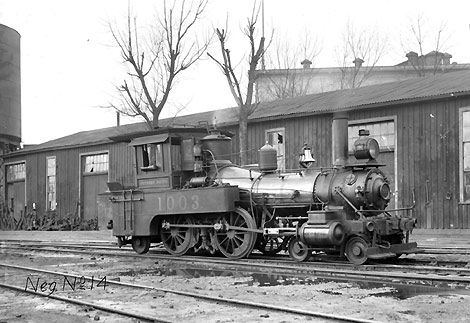 |
tank engines of the 'turn-back era' - During the early-mid 90's, SP owned a baker's dozen tank locomotives that were equipped with the pilot and trailing wheels that would have theoretically made them suitable for moderate speed bi-directional service. While some were employed as switch engines, there were likely candidates for turn-back service in the form of 1881 Sacramento Shops 2-6-2T's built for Oakland suburban service. Example SP #1903 (#1503 in the 90's) in the R. H. McFarland photo at upper left is (still-extant at CA State RR Museum). This class was twice as heavy as the elderly hodge-podge of other tank engines. An each-unique collection of three 4-4-2T's, such as #1003 seen here, came to California around the Horn as conventional 4-4-0 tender engines during the 1960', while four even smaller 2-4-2T's of varying dimensions such as #1004 clearly were not suited for the heavy grades on either side of Ocean View. Otherwise, conventional tender engines would have been required to run backwards in one direction, or somehow get down to San Jose (light, or added to another train) to be turned, unlikely at best.
|
|||
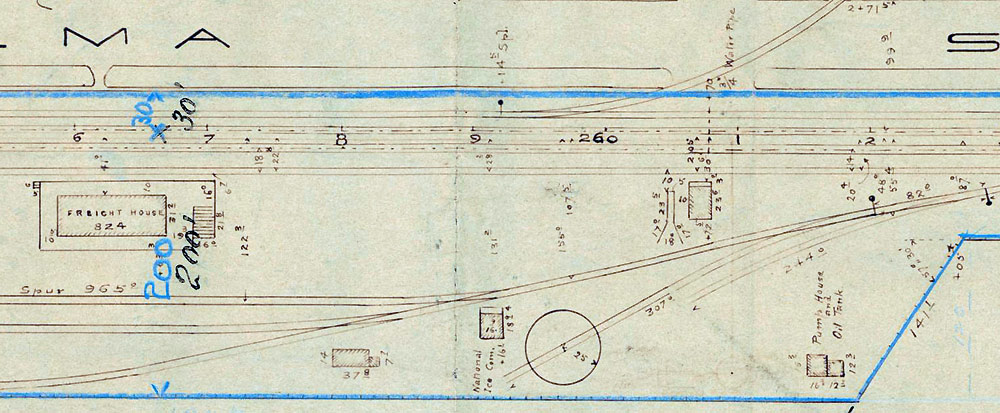
Above is an inverted-color image cropped from an online SP blueprint at Stanford Libraries (used with permission) showing the turntable and central yard tracks as they existed in 1904, shortly after the main line was double tracked. The turntable was out of service during part of 1904-05, but SP revived it and added at least one more storage track to the yard in preparation for Stanford's 1905 Big Game with Cal. The full blueprint depicting the yard from Embarcadero Road to San Francisquito Creek is located at: http://purl.stanford.edu/mr664hk6765 |
||||
| Excitement revolves around the turntable On one July afternoon in mid-1894, the routine was briefly altered by fallout from the Great Pullman Strike, which affected SP primarily in Central and Northern California. With most of Bay Area 'festivities' taking place over in the East Bay on the Western Division and subsidiary South Pacific Coast, a group of 10-12 Coast Division strikers, more or less led by four young firemen, rather extemporaneously decided that their home turf aught to be represented, so they set up a roadblock of sorts at Palo Alto. In the meantime, train #13, the eastbound (southbound) Del Monte Express 1, had terminated its run at College Park to let off a troop of state militia intending to deal with the strikers, who had the tracks tied up ahead. The crew then backed the train to Lawrence's Station, where they ran the engine around the cars and proceeded westbound using the schedule times of #6, which had been prevented from leaving San Jose. At Palo Alto, as they cut off the engine and sent it onto the turntable, where, from the company point of view, the militia would have come in handy. The crew had the loco about halfway turned when one of the strikers approached the engineer, saying, "We will take charge of the engine," and proceeded to shake the coal grates to kill the fire. Other strikers drained the water out of the tender. In the meantime, turn-back train #17 had come in from the north, and once they finished attending to #13's engine, the strikers moved over to similarly decommission the new arrival. |

Had the state militia still been on board #13, and had the strikers availed themselves of the inspiriting offerings at Menlo Park's watering holes, the Palo Alto affair arguably might have turned more violent, but as it was, nobody suffered so much as a black eye and the total physical damage was one bent switch. |
|||
|
For some reason, one of the strikers who had taken charge of the engine, decided to back up, and ran the tender and part of the engine through a switch set wrong, and then realizing his mistake, compounded the error by moving ahead through the now-split switch, derailing the engine right in front of the ticket office, which presently filled with steam. By now a large crowd of gawkers surrounded the drama, and as the engine sat awkwardly half-on and half-off the rail, from their midst came a shout of, "Hip, hip, hurrah for the A. R. U." (American Railway Union). After that, the strikers quietly left the scene, some of them headed towards Menlo Park. Striking could build up quite a thirst. The following morning, an engine was dispatched from San Francisco to drag the dead pair up to Menlo to refill their tanks for their trips home. Of note is that neither trains carried Pullmans, not that this mattered, because these men's grievances were not centered on the Pullman Company (one commented that he did not care about Pullman), but rather against SP's summary dismissal of Pullman strikers. The four leaders were prosecuted in Federal District Court under new Federal Antitrust laws the following year 2, but were subsequently acquitted. It did not take very long for the turn-back idea to run its course. Santa Clara Valley's population was increasing, as well, and it simply made more sense for a number of reasons to operate all trains the extra 17 miles to and from San Jose: better crew and locomotive utilization, the ability to have the locos fully serviced and repaired in-between runs, and significantly, the elimination of both maintenance expense and an attractive nuisance to children. The latter seems to have been a problem, given the turntable's proximal position to downtown. (I cannot imagine my father not playing on it.) Only one pair of trains showed on the summer schedules of 1895. By 1897, those trains had also vanished, probably during the general readjustment of Peninsula schedules that took place that year. After that, Palo Alto's turntable only was employed by special train movements, and perhaps an occasional local freight engine. In 1904 it claimed its only known injury when a theatre train baggageman named Moody was riding its locomotive's front step when he became"badly twisted and squeezed" in between it and the turntable's framework. This report of misfortune tells us that the turntable was of wooden "gallows" construction rather than the other type commonly employed by SP at the time, a cast iron product of William Sellers & Company. |
||||
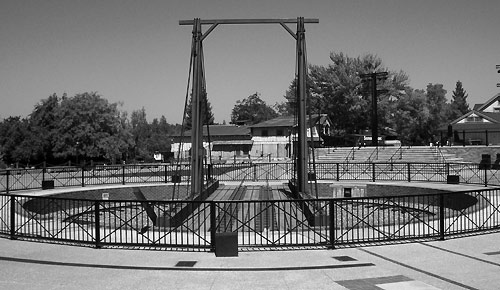
The Moody accident strongly suggests that Palo Alto's turntable was an SP standard "gallows" type wooden turntable. SP's iron turntables of the time did not have the superstructure over the tracks seen here. The table seen above is a modern reconstruction of one constructed at Folsom in the 1880's. - Wikimedia Commons |
Following the incident, the debilitating effects of a decade's-worth of weather on the untreated wooden superstructure caused its removal of service, but this was temporary. Stanford football was by now a big thing, particularly in the context of its rivalry with its Berkeley archnemesis, University of California. Their annual Big Games had for some time been popular-enough to command special trains between Palo Alto and San Francisco to handle the cross-bay flood of fans fans. It was Stanford's biennial turn to host the match-up in 1905, and university officials had become concerned about congestion at Palo Alto depot during arrival and departure of the specials. Through 1899, the movements used Stanford's so-called Bon Aire Switch at Mayfield to access the stadium via a spur constructed in the 1880's to feed sandstone from SP's Almaden Branch (also constructed to facilitate stone haulage) the university's original quad location. In 1901 and presumably also in 1903, SP declared the track condition to be too risky for passenger movements, so the trains called at Palo Alto depot, about a mile from the stadium instead. In 1905 neither arrangement was appealing as-is to SP, since with the turntable now out of service, it faced the prospect of deadheading trains to and from San Jose to turn their locomotives in preparation for post game operations. Beyond that, Palo Alto had insufficient track capacity to store sufficient equipment needed to handle the anticipated crowds. The single track main would be plugged for a good part of the evening. At the time, the Peninsula was the most heavily trafficked piece of railroad west of the Mississippi. | |||
| With the Big Game fast-approaching in the summer of 1905, Stanford officials asked SP's operating department to come up with a solution with an eye on returning the trains to Stanford via the Bon Aire Switch. SP answered with a plan that would turn the switch location into a wye and add a loop to the far end of the Stanford Spur. This spurred discussions about real estate acquisitions and the general nature of the work that dragged on into fall. In early October, just as arrangements appeared to be settled, Stanford's trustees intervened with a refusal to grant right of way for the loop. Rather than deal further with the university, SP came up with a last minute stop gap plan that satisfied its own needs. It would buld a new storage track at Palo Alto and repair the old turntable to eliminate the deadheads. As far as congestion at the depot and the logistics of getting game-goers over the mile to the Stadium was concerned, SP was content to allow Stanford to stew in its own juices. The game was schedule for November 12, so onstruction began in haste. Crews were reported as still involved in grading and track laying only three days before the event, but all was ready the night before, when a ten car theatre train made a turn to Palo Alto out of San Francisco. On game day, an unknown number of specials operated out of San Francisco and a "rooter's train" packed with 600+ passengers operated out of Berkeley via Oakland and San Jose.3 In 1908, Stanford finally got around to rebuilding the spur with all new rail, but by that time such work was on the verge of being superfluos, for in August 1909, another Big Game year at Stanford, E. H. Harriman's newly incorporated Peninsular Railway announced that, as part of expanding its recently-absorbed San Jose-Los Gatos Interuban Railway, it would build a short spur to the stadium. Southern Pacific trains were to be accomodated via a spur track that connected to the interurban line from a new wye to be constructed at the turntable site near the freight house. On Big Game Day, November 13, SP ran nine special trains to and from San Francisco, as well as one from Berkeley, way beyond the turntable's capacity to handle engines in a timely manner, but it was no more. |
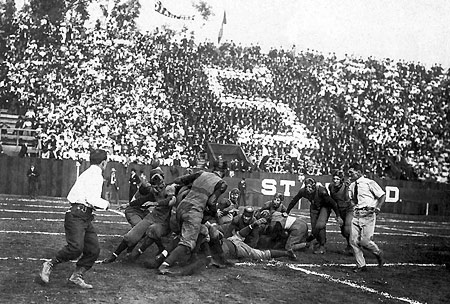
The 1905 Stanford - Cal Big Game was the last American rules football matchup between them until 1914. During the interim, rugby football rules guided play. - Wikimedia Commons |
|||
|
End Notes 1. In SP parlance, "eastbound trains were those headed away from San Francisco and were given odd numbers; headed towards San Francisco, even. Later in the decade this was reversed. The Del Monte Express was the dialy, except Sunday train. The well-remebered Del Monte Limited, which ran until 1971, was then a Saturday-only affair. 3. Initially, Federal Antitrust laws were used to prosecute union activity, not the excesses of large corporations. A searchable PDF of the court case syllabus, featuring witness testimony about events, is available from Wx4. 3. Stanford won, 12-5. This was the last American rules football contest between the two teams for several years. Concerned about the violence involved (read about the pounding Red Grange took during his career, sometime), both teams adopted rugby rules football. Sources The preponderance of the information utilized here comes from the Palo Alto City Digital Collection, Historical Newspaper Collection and The Stanford Daily Archives. - E.O. Gibson, Wx4.org, June, 2021 |
||||
